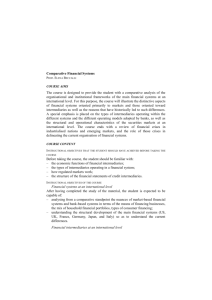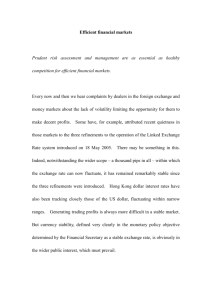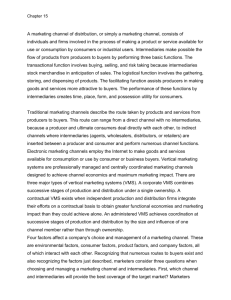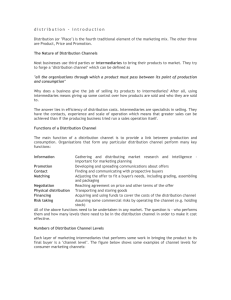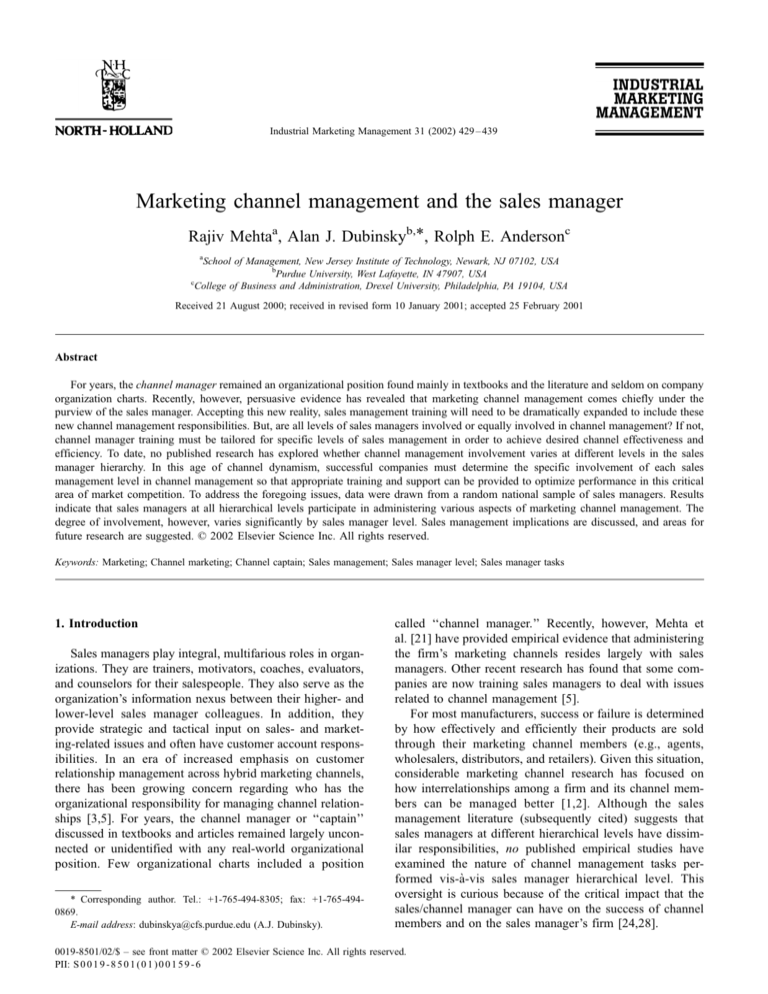
Industrial Marketing Management 31 (2002) 429 – 439
Marketing channel management and the sales manager
Rajiv Mehtaa, Alan J. Dubinskyb,*, Rolph E. Andersonc
a
School of Management, New Jersey Institute of Technology, Newark, NJ 07102, USA
b
Purdue University, West Lafayette, IN 47907, USA
c
College of Business and Administration, Drexel University, Philadelphia, PA 19104, USA
Received 21 August 2000; received in revised form 10 January 2001; accepted 25 February 2001
Abstract
For years, the channel manager remained an organizational position found mainly in textbooks and the literature and seldom on company
organization charts. Recently, however, persuasive evidence has revealed that marketing channel management comes chiefly under the
purview of the sales manager. Accepting this new reality, sales management training will need to be dramatically expanded to include these
new channel management responsibilities. But, are all levels of sales managers involved or equally involved in channel management? If not,
channel manager training must be tailored for specific levels of sales management in order to achieve desired channel effectiveness and
efficiency. To date, no published research has explored whether channel management involvement varies at different levels in the sales
manager hierarchy. In this age of channel dynamism, successful companies must determine the specific involvement of each sales
management level in channel management so that appropriate training and support can be provided to optimize performance in this critical
area of market competition. To address the foregoing issues, data were drawn from a random national sample of sales managers. Results
indicate that sales managers at all hierarchical levels participate in administering various aspects of marketing channel management. The
degree of involvement, however, varies significantly by sales manager level. Sales management implications are discussed, and areas for
future research are suggested. D 2002 Elsevier Science Inc. All rights reserved.
Keywords: Marketing; Channel marketing; Channel captain; Sales management; Sales manager level; Sales manager tasks
1. Introduction
Sales managers play integral, multifarious roles in organizations. They are trainers, motivators, coaches, evaluators,
and counselors for their salespeople. They also serve as the
organization’s information nexus between their higher- and
lower-level sales manager colleagues. In addition, they
provide strategic and tactical input on sales- and marketing-related issues and often have customer account responsibilities. In an era of increased emphasis on customer
relationship management across hybrid marketing channels,
there has been growing concern regarding who has the
organizational responsibility for managing channel relationships [3,5]. For years, the channel manager or ‘‘captain’’
discussed in textbooks and articles remained largely unconnected or unidentified with any real-world organizational
position. Few organizational charts included a position
* Corresponding author. Tel.: +1-765-494-8305; fax: +1-765-4940869.
E-mail address: dubinskya@cfs.purdue.edu (A.J. Dubinsky).
called ‘‘channel manager.’’ Recently, however, Mehta et
al. [21] have provided empirical evidence that administering
the firm’s marketing channels resides largely with sales
managers. Other recent research has found that some companies are now training sales managers to deal with issues
related to channel management [5].
For most manufacturers, success or failure is determined
by how effectively and efficiently their products are sold
through their marketing channel members (e.g., agents,
wholesalers, distributors, and retailers). Given this situation,
considerable marketing channel research has focused on
how interrelationships among a firm and its channel members can be managed better [1,2]. Although the sales
management literature (subsequently cited) suggests that
sales managers at different hierarchical levels have dissimilar responsibilities, no published empirical studies have
examined the nature of channel management tasks performed vis-à-vis sales manager hierarchical level. This
oversight is curious because of the critical impact that the
sales/channel manager can have on the success of channel
members and on the sales manager’s firm [24,28].
0019-8501/02/$ – see front matter D 2002 Elsevier Science Inc. All rights reserved.
PII: S 0 0 1 9 - 8 5 0 1 ( 0 1 ) 0 0 1 5 9 - 6
430
R. Mehta et al. / Industrial Marketing Management 31 (2002) 429–439
Steep sales management hierarchies are pervasive in
many firms, with sales managers assigned to different
organizational levels. The combination of supervisory,
managerial, administrative, and leadership skills required
for superior performance at lower sales management levels
seemingly is not consonant with that needed at higher levels
[4]. In fact, prior work has discerned that sales managers’
perceptions of their role vary by sales management level
[22]. This finding, in concert with the paucity of research on
and importance of the sales manager/channel management
connection, begs the following question: ‘‘Do channel
management activities performed by sales managers vary
across the sales management hierarchy?’’ We seek to
address this issue in the present work.
Exploring the influence of sales management hierarchical
level on channel management activities is important for
several reasons. First, conventional wisdom and sales management and marketing textbooks suggest that sales managers play a critical role in planning, organizing, managing,
directing, and controlling the sales department. If their
efforts, however, also focus on channel management (as
recent conceptual and empirical work implies), then expansion and revision of the traditional role of sales managers
will be necessary. Many sales manager training programs
have yet to recognize and address their sales managers’
involvement in channel management [5]. Second, if channel
management activities performed by sales managers vary
by managerial level, then companies need to redesign their
development and training programs to adjust to the unique
requirements of each sales management level. An important
objective of the present research is to obtain useful
information that organizations can utilize to provide appropriate channel management training to sales managers at
different hierarchical levels congruent with the nature of the
tasks performed. Otherwise, companies may waste large
amounts of time, money, and resources in providing inappropriate training to their sales managers. Third, Czinkota
et al. [11] opine that the sales manager’s responsibility for
managing the entire interface with the customer is possibly
the most crucial ingredient necessary for sustained company
success. This phenomenon has become particularly evident
in recent years as the number and types of marketing
channels used to interact with customers (e.g., the Internet
and extranets) has proliferated, and the job of channel
manager becomes increasingly complex and important for
competitive advantage. Before appropriate training can be
offered to prepare sales managers for this channel complicacy, companies must determine which levels of sales
management are most involved in channel management
and thus require the most extensive and intensive training.
Are lower-level sales managers who are generally tactically oriented and in daily contact with customers more
involved, or are higher-level sales managers with their
strategic concerns more involved [4,8,14]? Identifying
whether and specifically how the performance of channel
management activities varies by sales management level
could, through more effective and efficient channel training,
lead to a highly positive impact on the company’s relationships with their channel member customers and ultimately
greater profitability.
We begin by providing an overview on marketing
channel management. Next, the paper discusses sales manager hierarchical levels and proffers hypotheses. Then, the
research method is discussed, followed by the findings of
the study. Finally, managerial implications and directions for
future research are suggested.
2. Marketing channel management
Marketing channels can be defined as the set of external
organizations that a firm uses to achieve its distribution
objectives. Essentially, a channel is the route, path, or
conduit through which products or things of value flow,
as they move from the manufacturer to the ultimate user of
the product [28]. The marketing channel (interorganizational network of institutions comprised of agents, wholesalers, and retailers), by performing a variety of distribution
tasks, plays a significant role in the flow of products from
producers to consumers and on company profitability. Thus,
manufacturers are increasingly concerned about the level of
performance their channel institutions provide [24].
Like other areas of business, marketing channels require
careful administration, as superior channel management
policies and strategies help a firm attain a differential advantage but concomitantly are difficult to duplicate [16].
Marketing channel management refers to the process of
analyzing, planning, organizing, and controlling a firm’s
marketing channels [28]. As discussed in numerous articles
and textbooks, it comprises seven decision areas: (1) formulating channel strategy, (2) designing marketing channels,
(3) selecting channel members, (4) motivating channel
members, (5) coordinating channel strategy with channel
members, (6) assessing channel member performance, and
(7) managing channel conflict [24,25]. All seven areas are
critical to superior market performance and long-term
customer loyalty [21]. Consequently, the linkage of these
seven channel functions with sales management is the
focus of our investigation. Although viable companies
must skillfully manage all of their channel activities, which
sales managers are doing which of the seven areas is
unclear [21,26]. Ambiguity surrounding the responsibility
for and performance of any of these important channel
functions can adversely affect customer relationships and
company profits.
2.1. Formulating marketing channel strategy
Channel strategy refers to the broad set of principles
by which a firm seeks to achieve its distribution objectives [24]. It focuses on devising channel tactics pertaining to issues such as the role that distribution should play
R. Mehta et al. / Industrial Marketing Management 31l (2002) 429–439
in the firm’s overall corporate objectives and strategies,
the role distribution should play in the firm’s marketing
objectives and strategies, and the congruency that exists
between channel strategy and the marketing mix. Locating
new markets in which the firm’s products can be marketed and suggesting new technologies that can make
marketing channels more efficient are examples of channel strategy decisions.
431
strategic role. In essence, a manufacturer devises various
motivational programs to induce channel intermediaries to
exert higher levels of effort in serving the firm’s target
market [24,29]. Some motivational strategies commonly
used by firms to induce channel member cooperation
include paying higher slotting allowances, offering higher
trade discounts, providing strong advertising and promotional support, training channel members’ salespeople,
and offering superior logistical support [25].
2.2. Designing marketing channels
2.5. Coordinating marketing channel strategy
Channel design refers to the development of new channels or the modification of existing channel structures.
Anderson et al. [2] note that marketing channels must be
aligned with the firm’s overall objectives and competitive
strategy. Devising the structure or ‘‘architecture’’ of the
marketing channel system entails four key channel design
dimensions: (a) number of levels in the channel, i.e., the
number of intermediary levels between the manufacturer
and ultimate users, (b) intensity at the various levels, i.e.,
the number of intermediaries at each level, (c) types of
intermediaries, i.e., particular kinds of middlemen, and (d)
number of channels, viz., single, dual, or multiple marketing channels.
The foregoing dimensions typically produce a number of
possible channel alternatives. These alternatives must be
evaluated in light of an array of variables, such as served
markets, product types, and germane environmental and
behavioral factors. Analyzing the channel alternates can be
extremely complex because several approaches and quantitative models may be utilized in identifying and then
implementing the optimal channel structure [25].
2.3. Selecting marketing channel members
Once the marketing channel has been designed, channel
members are selected to represent a firm and resell its
products to final customers. Initially, prospective channel
members are found and assessed for ‘‘fit.’’ To do this, a
prospective channel member’s credentials (e.g., credit history, reputation, number of product lines, market coverage,
and number of salespeople) need to be examined for
congruency with the manufacturer’s marketing objectives.
Ultimately, the producer secures and converts prospects to
formal channel members by offering them various motivational inducements [28].
2.4. Motivating marketing channel members
As independent institutions, channel members are not
under the direct control of the firms they represent; as a
result, they do not automatically cooperate and comply with
manufacturer requests. Thus, producers need to take administrative actions to secure channel intermediaries’ cooperation as well as to maintain and improve channel
effectiveness. So, motivating channel members plays a
Marketing channels have conventionally been viewed as
a network of dissimilar but interdependent institutions that
have coalesced together for purposes of trade. Marketing
channel scholars have long promulgated the need for
coordinating and integrating channel activities with other
departments of a firm. Coordination in an interorganizational setting of marketing channels includes relaying information on new channel policies or communicating the
launch of sales promotion programs to its channel members.
Such efforts are undertaken to ensure that all channel
participants are cognizant of the manufacturer’s marketing
activities with respect to channel members. Despite the
differing goals of independent channel participants, coordination of the channel is necessary to reduce the redundancy
of work effort and the inefficient allocation of distribution
tasks among channel members [24].
2.6. Assessing marketing channel member performance
Channel member performance represents the degree to
which the channel member engages in behavior that contributes to the fulfillment of the channel leader’s objectives
[25]. As previously noted, firms have become increasingly
reliant upon channel members for the efficient and effective
performance of marketing functions. Moreover, the level of
performance attained by channel members is pivotal for a
firm’s achieving a competitive advantage [16]. Thus, by
assaying the performance of channel members, manufacturers can discern how successful they have been in implementing channel strategies as well as achieving their
distribution objectives.
2.7. Managing marketing channel conflict
Marketing channels can be viewed as social systems
influenced by behavioral dynamics (such as channel conflict) that are associated with all social systems [29].
Conflict in marketing channels, which has been the focus
of numerous channel investigations (see review by Gaski
[15]), refers to goal-impeding behavior by one or more
channel members. Thus, when one channel member takes
actions that another channel participant believes will reduce
its ability to achieve its objectives, conflict is present. As
conflict can have an adverse effect on channel member
432
R. Mehta et al. / Industrial Marketing Management 31 (2002) 429–439
performance [15], channel managers must make conscious
efforts to detect and resolve it.
3. Hypotheses
Organizational hierarchy is a key facet of firms. As with
other types of personnel, managers are usually assigned to
their positions based on their area of expertise and thus
perform activities and tasks that are divergent from those of
their lower- and higher-level managerial counterparts. For
example, Gomez-Mejia et al. [17] indicate that lower-level
managers focus on supervising subordinates, whereas
higher-level managers concentrate on activities such as
strategic planning, monitoring business indicators, evaluating organizational performance, and coordinating tasks
among the different functional areas of business. As they
are promoted to more senior positions, managers become
less involved with managing line workers. Furthermore, at
lower levels of the organizational hierarchy, jobs are more
clearly defined and have shorter-term objectives; jobs in the
higher hierarchical levels, though, are less clearly defined,
with more emphasis placed on the attainment of long-term
strategic goals [20].
These descriptions are analogous to positions in an organization’s sales management hierarchy. Futrell [14] categorizes sales management positions into lower, intermediate,
and higher levels. He maintains that as sales managers ascend
the hierarchy, conceptual and decision-making skills become
more critical while technical skills become less important.
Anderson et al. [4] state that lower-level sales managers
require ‘‘supervisory ability,’’ intermediate-level managers
‘‘managerial ability,’’ and higher-level managers ‘‘administrative and leadership ability.’’ They further posit that at
the higher levels of the sales management hierarchy, the
requirements of the managerial position change markedly.
For example, higher-level sales managers (national or general) communicate overall corporate strategy to mid- and
lower-level sales managers, who are responsible for executing the sales plans in their respective geographical areas.
Additionally, higher-level sales managers participate in
strategic and tactical planning and direct and communicate
top-level decisions regarding marketing and sales objectives to district or regional sales managers. Intermediatelevel sales managers (district or regional) are responsible
for managing sales operations in relatively smaller geographical zones. Responsible for monitoring daily operations of sales personnel, lower-level sales managers (field
or branch), are first-line managers who report to district
and regional sales managers. When compared to their
higher-level counterparts, field and branch sales managers
preside over the management of relatively smaller salesforce subdivisions.
One recent study provides support for the foregoing
suppositions. Mehta et al. [22] examined sales managers’
perceptions of their role orientations at lower, intermediate,
and upper levels. They found that upper-level sales managers believe that having a profit focus is more important than
do their intermediate- and lower-level counterparts. Also,
they observed that upper-level sales managers perceive that
having a cost focus is more critical than do their lower-level
subalterns. In addition, upper-level sales managers believe
that the ability to integrate sales and marketing has greater
significance than do intermediate-level sales managers.
These financial and integrative emphases of upper-level
sales managers compared to their lower-level counterparts
are clearly indicative of strategic issues and concerns.
Managing a channel of distribution arguably is a strategy-related issue holding great significance for many manufacturers. The management of a channel will have a
dramatic impact on channel member satisfaction and performance, customer satisfaction, and company profitability.
The previous dialectic implies that as sales managers
ascend the organizational hierarchy, they become increasingly focused on strategy-related issues. As such, then,
sales managers in higher organizational levels are more
likely to engage in the seven channel management decision
areas (discussed earlier) than are sales managers in lower
organizational levels. In investigating the different hierarchical levels of sales management, we have adopted the
classification categories typically used in the literature
(e.g., Refs. [4,8,14,22]). Specifically, the following hypotheses are posited:
Hypothesis 1: Intermediate-level sales managers are
more likely to engage in (a) formulating channel strategy,
(b) designing marketing channels, (c) selecting channel
members, (d) motivating channel members, (e) coordinating channel strategy, (f) assessing channel member
performance, and (g) managing channel conflict than are
lower-level sales managers.
Hypothesis 2: Upper-level sales managers are more
likely to engage in (a) formulating channel strategy, (b)
designing marketing channels, (c) selecting channel
members, (d) motivating channel members, (e) coordinating channel strategy, (f) assessing channel member
performance, and (g) managing channel conflict than are
lower-level sales managers.
Hypothesis 3: Upper-level sales managers are more
likely to engage in (a) formulating channel strategy, (b)
designing marketing channels, (c) selecting channel
members, (d) motivating channel members, (e) coordinating channel strategy, (f) assessing channel member
performance, and (g) managing channel conflict than are
intermediate-level sales managers.
4. Research methodology
4.1. Sample
A national sample of 500 sales managers representing
manufacturing firms was randomly selected from the
R. Mehta et al. / Industrial Marketing Management 31l (2002) 429–439
internal databases of a commercial mailing list company. An
introductory letter was mailed to all sample members. It
elicited their participation in the study, explained the intent
of the investigation, and informed them to expect a survey
in the mail the following week. Then, a packet containing a
cover letter, the survey, and a preaddressed, postage-paid
reply envelope was mailed to all sample members. After 1
week had elapsed, a follow-up letter was mailed reminding
survey respondents to complete and return the survey within
the prespecified time period.
A total of 158 usable questionnaires was received for an
effective response rate of 32%. This figure compares favorably with those reported in other studies in sales management
(e.g., Refs. [13,30]) and marketing channel management
(e.g., Refs. [1,18,19]). Reported in Table 1 is a summary
of the sample demographic and organizational information.
Nonresponse bias was assessed using two procedures.
First, as suggested by Churchill [7], 30 randomly selected
nonrespondents were contacted by telephone and asked to
provide information about organizational and personal
characteristics. c2 and t tests were calculated to determine
whether any differences existed between respondents and
nonrespondents with regard to key respondent and organizational characteristics. No statistically significant differ-
Table 1
Organizational and demographic characteristics of respondents
Characteristics
Primary activity of firm
Manufacturing consumer products
Manufacturing industrial products
Annual sales volume
Below US$10 million
US$10 – 49 million
US$50 – 99 million
US$100 million and above
Number of employees
Under 50 employees
50 – 99 employees
100 – 499 employees
500 employees and above
Number of wholesalers
Under 10 wholesalers
10 – 49 wholesalers
50 – 99 wholesalers
100 or more wholesalers
Number of retailers
Under 10 retailers
10 – 49 retailers
50 – 99 retailers
100 or more retailers
Level of sales managers
Lower-level (field or branch)
Intermediate-level (district or regional)
Higher-level (general or national)
Experience
Number of years a sales manager
Number of years with current firm
Percentage
53.2
46.8
55.1
30.4
7.6
6.9
38.0
19.6
33.5
8.9
48.7
23.4
8.9
19.0
57.0
11.4
3.5
28.1
29.7 (n = 47)
31.7 (n = 50)
38.6 (n = 61)
8.86 (average in years)
9.70 (average in years)
433
ences ( p < .05) were discerned. As advocated by Armstrong
and Overton [6], the second test for nonresponse bias examined the difference between early and late respondents on the
same set of factors. Again, nonsignificant results were
obtained. Consequently, nonresponse bias does not appear
to pose a significant problem in the present investigation.
4.2. Measures
Existing scales were unavailable to assess the channel
management constructs of interest in this study. Thus,
measures employed in this investigation were developed
after a review of relevant literature in various marketing,
channel management, and sales management textbooks
(e.g., Refs. [4,14,25,28]), articles on marketing channels
management (e.g., Refs. [1,2,15,18]), and articles on sales
management (e.g., Refs. [5,9,12,13]).
After a preliminary questionnaire was devised, two steps
were taken to enhance content validity of the scales. First,
15 sales managers employed by major corporations located
in a large metropolitan city were asked to assess whether the
items were tapping the major constructs of interest in this
study. Following a few minor editorial changes, the survey
was subsequently pretested using a convenience sample of
30 sales managers. Responses from the pretest necessitated
no further changes to the questionnaire.
4.2.1. Channel management items
The questionnaire was devised to assess the sales
manager’s involvement in marketing channel management practices. Specifically, sales managers were asked
to indicate the extent to which they performed tasks
pertaining to the following (previously discussed) seven
areas of channel management: (1) formulating channel
strategy, (2) designing marketing channels, (3) selecting
channel members, (4) motivating channel members, (5)
coordinating channel strategy with channel members, (6)
assessing channel member performance, and (7) managing channel conflict. In addition, the survey sought
information on general company characteristics and personal data of respondents.
A total of 42 items was used to tap the seven areas of
marketing channel management. Each item began with the
phrase ‘‘I am involved in . . .’’; the response format for all the
scales ranged from ‘‘strongly disagree’’ (1) to ‘‘strongly
agree’’ (5). It was deemed that self-reporting by responding
sales managers would yield the most accurate information as
to whether and to what extent they were involved in a
particular channel activity. Perceptions of superiors, subordinates, or customers likely would not be as accurate since
their focus is on their own activities. Moreover, each completed survey was carefully checked to make sure that
respondents were differentiating across each channel management activity regarding their level of involvement. The
composite value for each construct was computed by summing and then averaging the rating score for all items that
434
R. Mehta et al. / Industrial Marketing Management 31 (2002) 429–439
of the variation for assessing channel member performance
(eigenvalue = 3.64), and 67.8% of the variation for managing conflict (eigenvalue = 2.03).
Reliability of the multiitem scales was assessed using
Cronbach’s coefficient a [10]. As reported in Table 2, the
reliability estimates were .80 for formulating channel strategy, .85 for designing marketing channels, .86 for selecting
channel members, .89 for motivating channel members, .73
for coordinating channel strategy with channel members,
.85 for assessing channel member performance, and .76 for
managing conflict. Thus, these scales possess sufficient
reliability [23].
displayed factor loadings above 0.50 (discussed subsequently). Measures for each channel management construct
are shown in the Appendix A.
4.2.2. Sales management hierarchical level
Consistent with Leigh and Futrell [20] and Mehta
et al. [22], hierarchical (or managerial) level was operationalized using the position of the respondent sales
manager. Respondents reported whether they were a field,
branch, district, regional, general, or national sales manager. As Anderson et al. [4] promulgate, lower-level sales
managers can be considered field or branch supervisors
(n = 47); intermediate-level, district or regional sales managers, (n = 50); and higher-level, general or national sales
managers (n = 61). As with any organizational hierarchy,
job titles and responsibilities assigned tend to vary somewhat across companies, but respondents generally
reported titles and associated responsibilities that could
readily be classified into lower-, intermediate-, or higherlevel sales management. If there was doubt about the
hierarchical category to which a responding sales manager belonged, in-depth review of the types of sales
management (not channel management) activities in
which he or she was most involved resolved the classification issue.
4.3. Data analysis
Data were analyzed using three statistical procedures.
First, the data were subjected to multivariate analysis of
variance (MANOVA) to examine the overall influence of
sales manager hierarchical level on all seven marketing
channel management activities. This analysis yielded a
statistically significant finding (Wilks’ l F-value = 2.67,
p < .001), thus indicating that sales manager hierarchical
level has an overall impact on the channel management
factors considered in the study.
Second, analysis of covariance (ANCOVA) was conducted (see Table 3) to determine whether the perceptions
regarding each of the channel management activities were
affected by sales management level (lower, intermediate,
and higher level). Respondents’ job tenure as a sales
manager was treated as a covariate because prior work
has found that this variable is related to sales organization members’ perceptions of the job (see review by
Comer and Dubinsky [9]). Additionally, company sales
revenue, primary activity (manufacturing consumer or
industrial products), number of wholesalers, and number
of retailers were included as covariates because these
organizational factors may be associated with the nature
of channel management activities the manufacturer performs [29].
Third, Scheffe’s [27] contrasts were computed on those
channel management activities evidencing a significant
sales management level effect. These were computed to
4.2.3. Construct validity and reliability
As recommended by Churchill [7], the construct validity
of the various measurement items that tapped each of the
seven constructs was assessed via principal components
factor analysis with varimax rotation. A factor loading of
0.50 was employed as a cutoff for item selection. All items
exhibited factor loadings of 0.54 and above. The statistics
reported in Table 2 reveal that a one-factor solution emerged
for each of the seven constructs. More specifically, the items
explained 51.5% of the variation for formulating channel
strategy (eigenvalue = 3.74), 49.9% of the variation for
designing marketing channels (eigenvalue = 4.49), 71.2%
of the variation for selecting channel members (eigenvalue = 2.85), 56.9% of the variation for motivating channel
members (eigenvalue = 4.55), 65.1% of the variation for
coordinating channel strategy (eigenvalue = 1.95), 60.6%
Table 2
Factor analysis and reliability results
Marketing channel management activities
Number of
items
Number of
factors extracted
Percent of
total variance
explained
Eigenvalue
Coefficient a
Formulating channel strategy
Designing marketing channels
Selecting channel members
Motivating channel members
Coordinating channel strategy
Assessing channel member performance
Managing channel conflict
9
9
4
8
3
6
3
1
1
1
1
1
1
1
51.5
49.9
71.2
56.9
65.1
60.6
67.8
3.74
4.49
2.85
4.55
1.95
3.64
2.03
.80
.85
.86
.89
.73
.85
.76
R. Mehta et al. / Industrial Marketing Management 31l (2002) 429–439
435
Table 3
ANCOVA results: influence of hierarchical level on sales manager channel management activities
Marketing channel
management activities
Selecting channel members
Designing marketing channels
Coordinating channel strategy
Assessing channel member
performance
Managing channel conflict
Formulating channel strategy
Motivating channel members
Overall sample
mean (S.D.) [Rank]
4.54
4.44
4.35
4.32
(0.71)
(0.63)
(0.81)
(0.78)
[1]
[2]
[3]
[4]
4.30 (0.83) [5]
4.27 (0.63) [6]
4.16 (0.86) [7]
LL sales managers
mean (S.D.) [Rank]
4.29
4.17
4.22
4.05
(0.92)
(0.70)
(0.79)
(0.86)
[1]
[3]
[2]
[4]
3.57 (1.11) [7]
3.95 (0.67) [5]
3.90 (0.89) [6]
IL sales managers
mean (S.D.) [Rank]
4.60
4.55
4.42
4.41
(0.41)
(0.57)
(0.79)
(0.71)
[1]
[2]
[3]
[4]
4.10 (0.87) [7]
4.38 (0.52) [5]
4.25 (0.77) [6]
HL sales managers
mean (S.D.) [Rank]
ANCOVA
results F-value
Significant
contrasts
[1]
[2]
[5]
[4]
5.76a
7.20a
1.51a
4.60a
HL > LL
HL>LL, IL>LL
––
HL>LL
4.33 (0.70) [6]
4.47 (0.59) [3]
4.30 (0.90) [7]
8.22a
10.05a
3.39a
HL>LL
IL>LL, HL>LL
––
4.70
4.59
4.42
4.43
(0.68)
(0.51)
(0.86)
(0.71)
Scheffe contrasts were calculated to determine statistically significant differences between each group of sales managers: LL = lower-level sales managers;
IL = intermediate-level sales managers; HL = higher-level sales managers. Only statistically significant contrasts ( p < .05) are reported.
a
p < .05.
identify whether there were any significant differences in
channel management activities between each pair of sales
management levels.
5. Results
Reported in Table 3 are descriptive statistics (mean,
standard deviation, and rank based on the mean score) for
each of the marketing channel management practices for the
overall sample and for each sales management level as well
as the results for the ANCOVA and Scheffe tests. Findings
are arranged in descending order based on the overall
sample’s mean score for each channel management practice.
In assessing the overall impact of sales management
level on each of the marketing channel management practices, the ANCOVA findings in Table 3 reveal that six of the
seven factors exhibit statistically significant differences
( P < .05). More specifically, sales manager hierarchical level
is related to perceptions of sales manager involvement in
selecting channel members, designing marketing channels,
assessing channel member performance, managing channel conflict, formulating channel strategy, and motivating
channel members. Sales manager hierarchical level, however, does not appear to be associated with one construct –
coordinating channel strategy (so it was omitted from subsequent analysis).
Scheffe tests for contrasts between pairs of each sales
management group’s involvement in marketing channel
management practices were also computed. As reported in
Table 3, seven significant contrasts ( p < .05) were discerned.
More specifically, higher-level sales managers feel more
strongly about their involvement in formulating channel
strategy, designing marketing channels, selecting channel
members, assessing channel member performance, and
managing channel conflict than do lower-level sales managers. Thus, Hypothesis 2a –c, f, and g receive empirical
support. In addition, relative to lower-level sales managers,
intermediate-level sales managers feel more strongly about
their involvement in formulating channel strategy and
designing channels; so, Hypothesis 1a and b are supported.
No significant contrasts ( p>.05) were manifested between
higher- and intermediate-level sales managers’ perceptions
vis-à-vis the seven channel management activities. Therefore, Hypothesis 3a – g are rejected. Also, no statistically
significant contrasts ( p>.05) were observed for motivating
channel members.
6. Discussion
Mean scores reported in Table 3 suggest that, irrespective
of hierarchical level, sales managers generally are actively
involved with channel management activities. With few
exceptions, sales managers at lower, intermediate, and upper
levels participate relatively actively in seven key facets of
channel management. The seven are formulating channel
strategy, designing marketing channels, selecting channel
members, motivating channel members, coordinating channel strategy, assessing channel member performance, and
managing channel conflict. Although the mean scores are
illuminating vis-à-vis the sales manager/channel management interface, ANCOVA findings indicate some major
differences with respect to the degree of involvement in
various channel management activities across the sales manager hierarchy.
In assessing the impact of sales manager hierarchical
level, six statistically significant differences in channel
management were found. These ANCOVA findings suggest
that there is a dissimilitude in the level of participation of
sales managers at different management levels with regard to
formulating channel strategy, designing marketing channel,
selecting channel members, motivating channel members,
assessing channel member performance, and managing
channel conflict. An examination of the mean scores suggests that as sales managers ascend to more senior levels,
they tend to increasingly administer these six facets of
marketing channels as compared to their lower-level subalterns. Scheffe test results denote precisely where the level
of participation differs.
The findings of the Scheffe tests indicate that higherlevel sales managers participate more in formulating chan-
436
R. Mehta et al. / Industrial Marketing Management 31 (2002) 429–439
nel strategy, designing marketing channels, selecting channel members, assessing channel member performance, and
managing channel conflict than lower-level managers. Also,
intermediate-level sales managers participate more in formulating channel strategy and designing marketing channels relative to lower-level sales managers. These results
seemingly suggest that the foregoing channel management
activities require more careful attention owing to their
strategic nature and thus are assumed chiefly by upperlevel sales managers.
The process of developing a channel of distribution is
a major undertaking incurring substantial resources, both
personal and financial. Also, major commitments are
made as efforts are directed at securing and establishing
enduring relationships between the manufacturer and
channel intermediaries. Then, once the channel is established, initiatives for attending to channel participant
needs are ongoing as is monitoring channel effectiveness.
This entire process focuses on maintaining both customer
and channel member satisfaction while attaining manufacturer organizational and marketing objectives. A deficiency in performing any of the above activities will
likely lead to channel underperformance and, hence,
manufacturer underperformance.
Essentially, channel design and implementation is a molar
(‘‘big picture’’) issue. Decisions pertaining to channel development are made in light of the firm’s organizational and
marketing strategy. Given this situation and the resulting
dramatic impact the distribution channel will have on the
effectiveness, efficiency, and ultimate profitability of the
manufacturer, empowering upper-level sales managers to
be responsible for channel management activities (rather than
their lower-level counterparts) is logical. After all, their
position in the management hierarchy tends to make them
privy to information about the direction of the firm and the
efforts it (or will) undertake to attain its goals. Also, they have
the final accountability for the firm’s revenue generation. The
inextricable linkage between the distribution channel, firm
success, and financial accountability then leads naturally to
the involvement in channel design by senior sales management. Simply stated, lower-level sales managers would most
likely not possess sufficient personal or organizational means
to be effective with such high-level decisions as channel
design and implementation.
At least three plausible explanations exist for the finding
that coordinating channel strategy is not affected by sales
manager hierarchical level. First, lower-level sales managers typically concentrate on leading, managing, and controlling the sales department as well as focusing on revenue
generation. When channel decisions, strategies, and company-wide policies are formulated by senior-level management, lower-level sales managers (as well as higher-level
counterparts) play an important role in relaying that tactical
information to their firm’s channel members for deployment. In other words, all sales managers consider coordinating channel strategy to be important because they serve
as critical conduits of information. Imparting critical
information increases the chances that the producer and
its channel participants will have a mutual cognizance and
synchronicity. Second, as the number of channel members
representing a firm increases, communicating changes in
channel policies and coordinating channel strategies become increasingly difficult (owing to the increased number
of information exchanges). Consequently, sales managers at
all levels of the firms are needed for effective communication across channel members. As firms use more and more
intermediaries, sales managers at all levels thus expend
effort in coordinating channels-related tasks, thereby reducing the redundancies in work effort among channel participants. Third, perhaps coordinating channel strategy is
not affected by sales manager hierarchical level because
there is no sufficient coordination being accomplished at
any sales management level. Logically, higher-level sales
management should seemingly be coordinating channel
strategy. If not, this may be an important area of training
needed by upper-level sales managers.
6.1. Sales and marketing channel management implications
The results obtained from this study offer useful sales and
marketing channel management implications. Companies no
longer have any excuse for not assigning clear-cut responsibility and appropriate channel management training to sales
managers at each hierarchical level. With fierce global
competition, a complex hybrid of channels, and the consequent growing need for skillful channel management in this
age of telecommunications, the job of channel manager has
become far too important and costly in terms of customer
relationships to remain ambiguous or diffused. Failure in any
of the important functions of channel management is too
potentially deleterious for any company to risk. Sales managers, especially those at the intermediate and higher levels,
are now doing the channel management jobs. Whether they
do them well or poorly will depend largely on the quality of
the people hired for sales management positions and the
ongoing training they receive.
In the context of recruiting sales managers, minimum
requirements for a person selected for a management
position are suitable expertise, interpersonal relationship
skills, and well-rounded ability to undertake the increasingly complex and eclectic nature of this job. The ‘‘traditional’’ sales manager job requires management expertise,
leadership, motivational skills, analytical ability for sales
forecasting, profitability analysis by market segments, and
assessment of salesperson performance. Also, though, a
superior ability to strategically manage and operate marketing channels is now required. Thus, screening criteria
should include the possession of requisite skills and
potential for administering all facets of the firm’s marketing channels in developing, maintaining, and furthering
loyal customer relationships. In short, only individuals who
manifest additional skills in marketing channel manage-
R. Mehta et al. / Industrial Marketing Management 31l (2002) 429–439
ment should be recruited, selected, and trained for this
expanded role of the sales manager.
According to Anderson [3], the current business environment requires sales managers to be ‘‘supermarketers.’’ As
such, both newly selected and incumbent sales managers
should be provided training that helps them integrate sales
with broader marketing functions. In a recent study, Anderson et al. [5] found that although newly recruited sales
managers recognize that sales management training is necessary for them to perform effectively, they also perceive that
their past skills are insufficient to succeed in their new jobs
without receiving further training. Sales management training
becomes increasingly urgent as traditional sales manager
roles and duties are dramatically changed through automation, salesperson empowerment, and buyer behavior
dynamism. Too often, however, sales managers receive little
training subsequent to that provided upon their initial
appointment to sales manager [5]. In the context of the
present investigation, sales managers should receive rigorous, regularly updated training in the following areas of
channel management: formulating channel strategy, designing marketing channels, selecting channel members, motivating channel members, coordinating channel strategy with
channel members, assessing channel member performance,
and managing conflict. Further, sales manager training
should emphasize particularly the careful design of marketing
channels as this is an extremely intricate process that requires
superior quantitative statistical skills and knowledge that can
be used to develop the ‘‘architecture’’ of the firm’s marketing
channel system. Moreover, this training should be continuous
as the conventional ‘‘sink-or-swim’’ attitude to sales manager
education is neither cost-effective nor appropriate in the
current-day supercompetitive markets. In short, the study’s
findings point to the growing need for sales managers at all
hierarchically levels (but especially intermediate and higher)
to develop expertise in channel management through ongoing
training beyond that provided for traditional sales management duties.
Emerging and rapidly proliferating electronic sales/marketing channels, such as the Internet, extranets, e-mails,
faxes, direct mail, television home shopping, and teleselling,
are making channel management increasingly difficult and
important. But, at the same time, electronic communication
channels, such as intranets, are helping sales managers in
their more traditional functions through use of empowered
salespeople with virtual, mobile sales offices that dramatically lessen their dependence on the flow of communication
from sales management. Overseeing a hybrid sales force
operating in diverse electronic and field channels and managing ongoing customer and channel member relationships
are activities that are combining to shift the job of sales
management toward that of channel management. Sales
managers at each hierarchical level will require specific
training for their channel management roles if their companies are to succeed in the new market competition. Every
company should review their current sales training practices
437
to ensure that they are entering the twenty-first century reality
with respect to channel management.
6.2. Limitations and directions for future research
This investigation augments our understanding of the
interface between sales and channel management by
empirically verifying the important role sales managers
at different hierarchical levels play in marketing channel
management. Its findings, however, should be considered
tentative owing to some limitations. First, primary market
offering (product vs. service) was not controlled in this
study. Because marketing channels for services tend to be
relatively short, channel management practices may be
significantly different from industrial and consumer products manufacturing firms. So, research is needed to
determine if channel management activities are influenced
by type of offering marketed.
Second, sales manager span of control was not considered in this study. Conceivably, as the number of
subordinates assigned to a sales manager increases, the
individual’s efforts will be increasingly diffused; this
phenomenon may lead to the manager’s allocating less
time to channel management tasks. Therefore, empirical
efforts should seek to ascertain if there is a difference in
channel management tasks owing to sales manager span
of control.
Hopefully, the current work will spawn future research
studies to increase our knowledge of sales management
positions as they change with the times. For instance,
subsequent studies could examine whether channel management training increases sales manager performance as
well as channel performance. Furthermore, inquiry might
be directed toward how sales managers can more efficiently and effectively manage the interrelationships
between a company and its marketing channel members
to create greater value for their ultimate customers.
Acknowledgments
The authors gratefully acknowledge the reviewers and
editor for their valuable comments.
Appendix A. Multi-item marketing channel
management scales
All items begin with ‘‘I am involved in’’:
Formulating channel strategy:
1. Monitoring competitive factors that may influence
the structure of my firm’s marketing channels.
2. Suggesting new technologies that can make my
firm’s marketing channels more efficient.
3. Determining the distribution objectives and policies for
my firm.
438
R. Mehta et al. / Industrial Marketing Management 31 (2002) 429–439
4. Determining the role that distribution will play in
achieving my firm’s overall marketing objectives.
5. Developing sales volume projections (quotas) that
intermediaries representing my firm are expected to meet.
6. Locating new markets in which my firm’s products can
be distributed.
7. Determining pricing policies (markups) for products that
are sold through intermediaries representing my firm.
8. Setting up an alternative trade discount structure when
the one used by my firm needs to be changed.
9. Specifying the inventory levels that intermediaries
representing my firm are expected to maintain.
Designing marketing channels:
1. Determining which different types of intermediaries
my firm’s products should be sold through.
2. Determining the number of each different type of
intermediary my firm’s products should be sold through.
3. Recommending adding and dropping intermediaries
representing my firm.
4. Modifying my firm’s marketing channels due to
changing demographic or market conditions.
5. Specifying the activities and functions that need to
be performed by the intermediaries representing my firm.
6. Setting up an alternative distribution structure if my
firm’s existing distribution network needs to be changed.
7. Determining the number of intermediaries needed to
cover each territory.
8. Assessing alternative methods of distribution for my
firm’s existing products.
9. Assessing alternative methods of distributing new
products developed by my firm.
Selecting channel members:
1. Selecting new types of intermediaries to represent
my firm.
2. Helping find prospective intermediaries to represent
my firm.
3. Determining the criteria that are to be used in
selecting intermediaries to represent my firm.
4. Inviting potential intermediaries to represent my firm.
Motivating channel members:
1. Promoting cooperation among the different
intermediaries that represent my firm.
2. Motivating the intermediaries who represent my firm.
3. Finding out the needs and problems of the intermediaries
who represent my firm.
4. Developing sales training programs to educate
intermediaries to sell my firm’s products.
5. Developing special price deals to assist intermediaries
in selling my firm’s products.
6. Devising cooperative promotional programs with
intermediaries representing my firm.
7. Developing special merchandising campaigns to
assist intermediaries in selling my firm’s products.
8. Developing displays and selling aids to assist
intermediaries in selling my firm’s products.
Coordinating channel strategy:
1. Coordinating promotional programs to assist
intermediaries in selling my firm’s products.
2. Communicating changes in my firm’s distribution
policies to the intermediaries who represent us.
3. Providing information on new products developed by my
firm for my firm’s intermediaries.
Assessing channel member performance:
1. Evaluating the performance of intermediaries
representing my firm.
2. Recommending corrective measures to help
poorly performing intermediaries do a better job.
3. Calculating the costs my firm incurs in
distributing products to its intermediaries.
4. Assessing the attitudes of our intermediaries towards
my firm’s products vs. our competitors’ products.
5. Assessing the attitudes of our intermediaries towards
the effectiveness of my firm’s promotional programs.
6. Assessing the attitudes of our intermediaries towards
the pricing policies of my firm.
Managing channel conflict:
1. Detecting conflict between independent
intermediaries representing my firm.
2. Resolving conflicts and misunderstandings
between intermediaries representing my firm.
3. Suggesting solutions to conflicts stemming from the
sale of products through my firm’s marketing channels.
References
[1] Achrol RS, Stern LW. Environmental determinism and decisionmaking uncertainty in marketing channels. J Mark Res 1988;25:
36 – 50 (February).
[2] Anderson E, Day GS, Rangan VK. Strategic channel design. Sloan
Manage Rev 1997;38:59 – 69 (Summer).
[3] Anderson RE. Personal selling and sales management in the new
millennium. J Pers Selling Sales Manage 1996;16:17 – 32 (Fall).
[4] Anderson RE, Hair JF, Bush AJ. Professional sales management. New
York: McGraw-Hill, 1992.
[5] Anderson RE, Mehta R, Strong J. An empirical investigation of sales
management training programs for sales managers. J Pers Selling
Sales Manage 1997;17:53 – 66 (Summer).
[6] Armstrong JS, Overton T. Estimating nonresponse bias in mail surveys. J Mark Res 1977;51:71 – 86 (July).
[7] Churchill GA. Marketing research: methodological foundations. Fort
Worth, TX: Dryden Press, 1991.
[8] Churchill GA, Ford NM, Walker OC. Sales force management. Homewood, IL: Richard D. Irwin, 1997.
[9] Comer JM, Dubinsky AJ. Managing the successful sales force. Lexington, MA: Lexington Books, 1985.
[10] Cronbach LJ. Coefficient alpha and the internal structure of tests.
Psychometrica 1951;16:297 – 334.
[11] Czinkota MR, Kotabe M, Mercer D. Marketing management: text and
cases. Cambridge, MA: Blackwell, 1997.
R. Mehta et al. / Industrial Marketing Management 31l (2002) 429–439
[12] Dubinsky AJ, Anderson RE, Mehta R. Selection, training, and performance evaluation of sales managers: an empirical investigation. J
Bus Bus Mark 1999;6(3):37 – 69.
[13] Erffmeyer RC, Russ KR, Hair JF. Needs assessment and evaluation
in sales training programs. J Pers Selling Sales Manage 1991;11:17 –
30 (Winter).
[14] Futrell CM. Sales management: teamwork, leadership, and technology. New York: Dryden Press, 1997.
[15] Gaski JF. The theory of power and conflict in channels of distribution.
J Mark 1984;48:9 – 29 (Summer).
[16] Ghemawat P. Sustainable advantage. Harv Bus Rev 1986;64:53 – 8
(September – October).
[17] Gomez-Mejia LR, McCann JE, Page RC. The structure of managerial
behaviors and rewards. Ind Relat 1985;24:147 – 54 (Winter).
[18] Heide JB, John G. The role of dependence balancing in safeguarding
transaction-specific assets in conventional channels. J Mark 1988;52:
20 – 35 (January).
[19] John G. An empirical investigation of some antecedents of opportunism in a marketing channel. J Mark Res 1984;21:278 – 89 (August).
[20] Leigh JH, Futrell CM. From the trenches to the command post: perceptual and attitudinal differences among levels in the marketing
management hierarchy. J Bus Res 1985;13:511 – 36 (December).
[21] Mehta R, Rosenbloom B, Anderson R. The role of the sales manager
in channel management: impact of organizational variables. J Pers
Selling Sales Manage 2000;20:81 – 8 (Spring).
[22] Mehta R, Anderson RE, Dubas K, Dubinsky AJ, Liu SS. How do
sales managers perceive their roles. J Manager Issues 1999;11:406 –
25 (Winter).
439
[23] Nunnally JC. Psychometric theory. New York: McGraw-Hill, 1978.
[24] Rosenbloom B. Marketing functions and the wholesaler-distributor:
achieving excellence in distribution. Washington, DC: Distribution
Research and Education Foundation, 1987.
[25] Rosenbloom B. Marketing channels: a management view. Hinsdale,
IL: Dryden Press, 1999.
[26] Rosenbloom B, Anderson RE. Channel management and sales management: some key interfaces. J Acad Mark Sci 1985;13:97 – 106
(Summer).
[27] Scheffe H. The analysis of variance. New York, NY: Wiley, 1959.
[28] Stern L, El-Ansary A, Coughlan AT. Marketing channels. Englewood
Cliffs, NJ: Prentice-Hall, 1996.
[29] Stern LW, Brown J. Distribution channels: a social systems approach.
In: Stern LW, editor. Distribution channels: behavioral dimensions.
Boston: Houghton Mifflin, 1969. p. 6 – 19.
[30] Sujan H. Smarter versus harder: an exploratory attributional analysis
of salespeople’s motivation. J Mark Res 1986;2:41 – 9 (February).
Rajiv Mehta is Associate Professor of Marketing at New Jersey Institute of
Technology.
Alan J. Dubinsky is Visiting Research Professor of Selling and Sales
Management at Purdue University.
Rolph E. Anderson is the Royal H. Gibson Sr. Professor of Marketing at
Drexel University.



